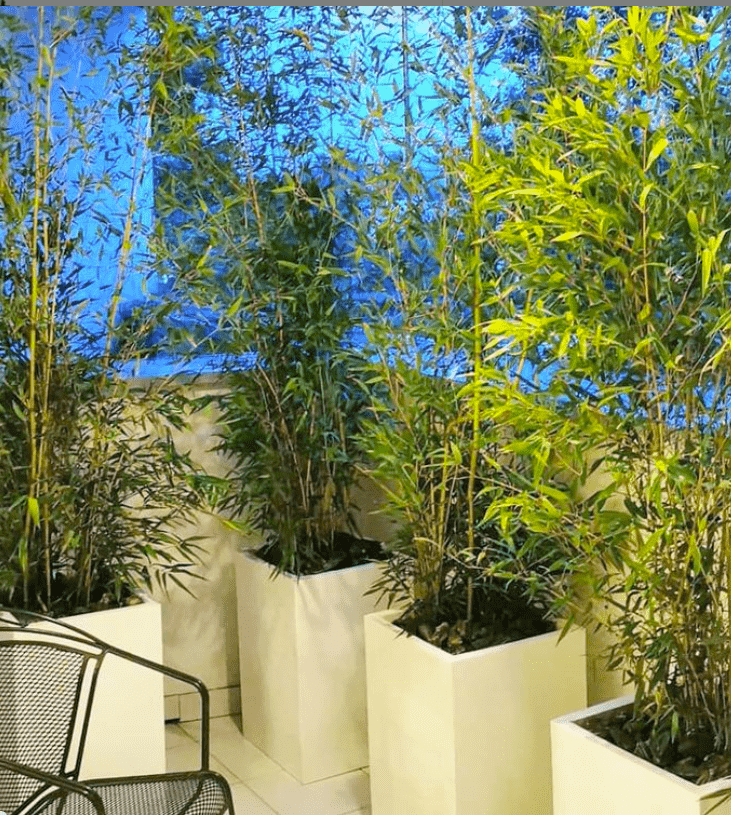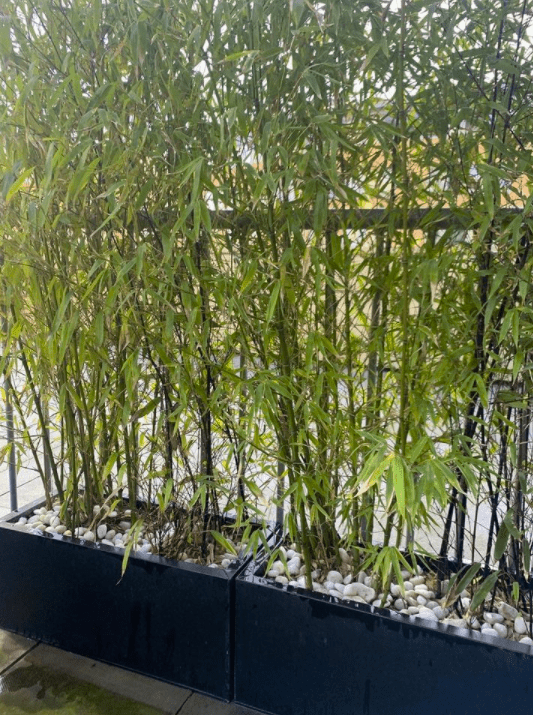Using bamboo as a natural privacy screen is a perfect option for balconies and other compact outdoor spaces. The plant is fast-growing, ideal in pots, and takes very little maintenance.
However, it’s worth looking into the different varieties of bamboo, as some are better suited to certain climates and growing conditions than others. You also might prefer the look of some bamboo varieties to others!
Luckily, that’s what we discuss in this article. Below, you’ll find information on the best bamboo privacy plants for balconies. We’ll go over the different types, show you what they look like as a privacy screen, and we’ll detail the pros/cons for each.
It’s worth noting that if you’re looking for information on ready-made bamboo fencing vs bamboo plants, you’re in the wrong place. Instead, check out our buyer’s guide on bamboo fencing.
Why Grow Bamboo?
Before getting into the different varieties of bamboo, you might be wondering why you’d want to grow bamboo in the first place. There are many benefits, including:
- Bamboo grows fast, making it a great choice for quickly decorating your balcony.
- It works great as a privacy screen because of its dense foliage.
- Bamboo is very easy to care for, meaning it’s ideal for people who usually struggle to keep plants alive.
- Keeping it in pots gives you flexibility with placement.
- Bamboo is a surprisingly pretty plant when grown properly.
Bamboo Planters
Choosing the right pots for your bamboo plants is vital. The plants are very strong and can break their way out of a pot if it’s particularly weak.
So, when growing bamboo in pots, follow these tips:
- Metal, concrete or thick wood pots are your only real option. Bamboo roots can crack through plastic pots.
- Railing planters are a definite no because they don’t offer enough space.
- The pot should have drainage holes and should be heavy enough that the plant won’t topple over in the wind.
- Pot size ultimately depends on the variety and intended height. A general rule for growing bamboo in pots for privacy is 18-20 inches deep and about the same in diameter.
The smallest pot you’ll want to choose is about 10-12 gallons. Larger is better, though, and something like a 25-30 gallon barrel is best.
Knowing the Difference Between Bamboo Types
There are 2 main types of bamboo: running and clumping. The best bamboo for privacy is clumping varieties because, as the name suggests, they form dense clumps of canes.
Running varieties are the most invasive and can spread throughout an entire garden if left alone. Obviously, this isn’t much of a concern here, as we’re only thinking about bamboo grown in pots.
As a general rule, running bamboo is better for privacy screens in larger outdoor spaces, such as gardens. They work best planted directly in the ground, although some areas ban you from doing this. Running bamboo can be almost impossible to fully remove once it’s established.
But, another thing we must consider is the climate. There’s a greater variety of running bamboo types, which can grow in almost all climate zones. Clumping bamboo, however, is more limited and a bit more fragile.
As such, we’ve included both types in our list of bamboo privacy varieties.
7 Best Bamboo Varieties for Privacy
We’ve based our top picks for the best bamboo for privacy on real varieties. However, these won’t be suitable for everyone, so we’ve also included the closest artificial alternatives. Renters will probably be better off with artificial bamboo – just expect to pay a decent amount for them.
1. Sunset Glow (Fargesia rufa)

As you can probably guess from the name, sunset glow bamboo has yellow canes and yellow-green leaves. It’s one of the fastest-growing types of bamboo, which is saying something.
It grows in USDA Zones 5-9 and can withstand temperatures down to -10F. A mature plant can reach up to 8ft. tall and 6ft. wide, although it won’t reach this size in pots.
The main advantage as a privacy bamboo variety is that it stays bushy down its canes. As such, it’ll provide a great screen for more open balconies.
Pros
- Hardy clumping variety
- Remains bushy
- Grows very fast
Cons
- It’ll quickly become pot-bound
To get this look:
2. Black Bamboo (Phyllostachys nigra)

Those looking for an edgy privacy bamboo variety need look no further. Black bamboo produces thick canes that turn black in their second year, giving it ultimate goth vibes.
It grows in USDA Zones 6-10, so is better suited to slightly colder climates than sunset glow. However, it only tolerates temperatures down to 0F, so you might need to bring it inside for the winter.
It’s another clumping variety and, if left alone, can reach up to 25ft. in height. On a balcony, though, it should be easy to keep it around 6-8ft.
Pros
- Interesting color
- Ideal for a privacy screen
- Very low maintenance
Cons
- Not as cold tolerant as other varieties
To get this look:
3. Multiplex Bamboo (Bambusa multiplex)

If sunset glow provides a bushy privacy screen, multiplex bamboo provides a living wall. The canes grow in a very dense arrangement, even for a clumping variety.
It’s a warmer variety than the others, needing USDA Zones 7-10. However, if you live farther north, sunset glow will be an ideal alternative. Mature plants can grow up to 30ft. tall, but you won’t achieve this in balcony pots.
The height and growing speed of multiplex bamboo mean it needs a bit more maintenance than other kinds, along with bigger pots. However, it’s still easy to care for compared to more sensitive plants.

Most fake bamboo plants (like in the image above) will mimic something like multiplex bamboo, which you can find here.
Pros
- Canes form a dense living wall
- Lush green color
- Can grow incredibly tall
Cons
- Needs slightly more maintenance than other privacy bamboo varieties
To get this look:
4. Yellow Groove Bamboo (Phyllostachys aureosulcata)

Yellow groove bamboo is closely related to black bamboo, but it’s a running variety. As such, it won’t reach its full potential in pots, but it’ll provide a decent privacy hedge regardless.
It’s ideal for USDA Zones 5-10, but in particularly cold climates (average winter temperatures between 0 and 25F), it might die off over the winter. So, you’ll either need to bring it indoors or not have a privacy hedge.
The canes are quite large and can reach a maximum height of 46ft. They make great support canes for other plants, too.
Pros
- Canes range from yellow to green
- Thicker canes than clumping varieties
- Fine for growing in pots
Cons
- Won’t be evergreen in cold climates
To get this look:
5. Blue Bamboo (Bambusa chungii)

You might already be able to tell that most bamboo variety names lack imagination. Blue bamboo is, unsurprisingly, blue. The canes start off green but develop a blue color as they age. Like yellow and black varieties, this adds interest to your privacy bamboo screen.
It grows in USDA Zones 9-11, so is the least tolerant one yet. It can withstand temperatures down to 21F, but prolonged exposure could impact its maximum growth.
Each plant can grow up to 25ft. tall and 10ft. wide. Of course, it’ll take a year or two for it to mature, and you can’t expect these sizes in a pot. However, with some care, it’ll make a great balcony privacy screen.
Pros
- Interesting powder blue color
- Ideal for pots in warmer climates
- Low-maintenance
Cons
- Not particularly cold tolerant
To get this look:
You’ll struggle to find an artificial version of blue bamboo. Instead, if you’re really set on having it, try painting the most yellow-toned bamboo you can find with watered-down blue paint. Something like denim blue or colonial blue should work best.
6. Bissetii Dwarf (Phyllostachys bissetii)

Despite being called a dwarf variety, bissetii can still grow up to 18ft. tall. However, this is short for bamboo plants, as you can probably tell by now.
It grows best in USDA Zones 4-8, so is the most cold-tolerant on this list. It’s ideal for pots and forms relatively small and dense clumps. As such, it’ll be a great balcony privacy screen.
Compared to other varieties, its canes are quite thin and it can quickly look leggy. You should be able to overcome this with annual pruning, though.
Pros
- Smaller variety for smaller spaces
- More cold tolerant than other kinds
- Perfectly suited to pots
Cons
- Bissetii can quickly look leggy without proper care
To get this look:
7. Golden Bamboo (Phyllostachys aurea)

If you’re paying attention to the Latin names, you can probably see golden bamboo is very similar to yellow groove bamboo. The difference lies in the color of their canes. Golden bamboo is completely yellow, whereas yellow groove, shockingly, has yellow grooves in green canes.
It’s another running kind, so growing it in pots is ideal for keeping it under control. Golden bamboo needs slightly warmer climates than yellow groove (Zones 6-10).
Although it’s a runner, it grows in dense clumps, so works well as a potted privacy plant. The dense foliage helps with this, too. Its golden color means it’ll add a pop of color to your balcony and would work well in a Mediterranean or boho themed space.
Pros
- Has dense foliage and canes
- Canes grow very quickly
- Ideal in pots despite being a running variety
Cons
- More sensitive to cold than some other kinds
To get this look:
Final Thoughts on Using Bamboo for Privacy
Finding the right kind of privacy bamboo for your balcony shouldn’t be too difficult. After all, bamboo is low-maintenance and grows well in pots. The biggest thing to look for is the Hardiness Zone, as this can have a big impact on the plant’s health.
This list should at least get you started. One final thing to look for is whether your state allows you to plant bamboo, as some ban it, even in pots!